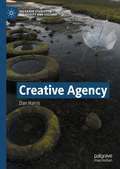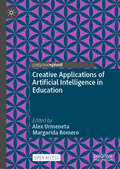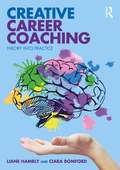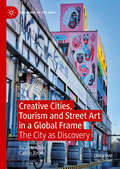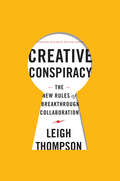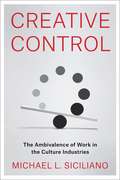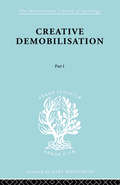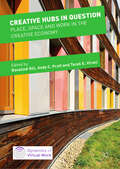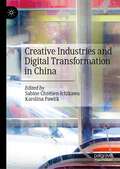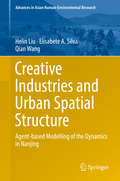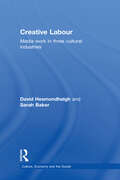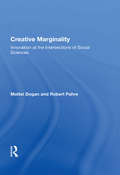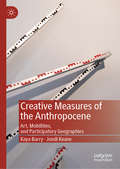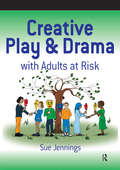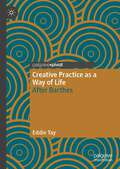- Table View
- List View
Creative Agency (Palgrave Studies in Creativity and Culture)
by Dan HarrisThis book offers a socio-cultural examination of contemporary creativity studies. Drawing heavily on posthumanist, new materialist and affective theoretics, the author argues in favour of an expansive and sustainable approach to creativity which contributes to an emergent ‘creativity studies’ inter-discipline. It seeks to establish a broader consideration of creativity in socio-culture, that extends beyond, or indeed refutes, the narrowing aperture of entrepreneurship and innovation as synonyms for creativity in economic, cultural and educational contexts and discourses. Drawing on multiple case studies of creative relational and creative ecological empirical research, this book integrates a concern for personal, planetary and geo-political collaboration, as an antidote for ‘innovation for innovation’s sake’.
Creative Applications of Artificial Intelligence in Education (Palgrave Studies in Creativity and Culture)
by Margarida Romero Alex UrmenetaThis open access book explores the synergy between AI and education, highlighting its potential impact on pedagogical practices. It navigates the evolving landscape of AI-powered educational technologies and suggests practical ways to personalise instruction, nurture human-AI co-creativity, and transform the learning experience. Spanning from primary to higher education, this short and engaging volume proposes concrete examples of how educational stakeholders can be empowered in their AI literacy to foster creativity, inspire critical thinking, and promote problem-solving by embracing AI as a tool for expansive learning. Structured in three parts, the book starts developing the creative engagement perspective for learning and teaching to then present practical applications of AI in K-12 and higher education, covering different fields (teacher education, professional education, business education) as well as different types of AI supported tools (games, chatbots, and AI assisted assessment). It also delves into the ethical considerations, policy implications, and the central role educators play in harnessing the power of an AI informed educational experience.
Creative Calling: Establish a Daily Practice, Infuse Your World with Meaning, and Succeed in Work + Life
by Chase JarvisLife isn’t about “finding” fulfillment and success – it’s about creating it. Why then has creativity been given a back seat in our culture? No longer.** A Wall Street Journal, Los Angeles Times and Publishers Weekly Bestseller **Creativity is a force inside every person that, when unleashed, transforms our lives and delivers vitality to everything we do. Establishing a creative practice is therefore our most valuable and urgent task - as important to our well-being as exercise or nutrition. The good news? Renowned artist, author, and CreativeLive founder, Chase Jarvis, reminds us that creativity isn't a skill—it's a habit available to everyone: beginners and lifelong creators, entrepreneurs to executives, astronauts to zookeepers, and everyone in between. Through small, daily actions we can supercharge our innate creativity and rediscover our personal power in life.Whether your ambition is a creative career, completing a creative project, or simply cultivating a creative mindset, Creative Calling will unlock your potential via Jarvis’s memorable “IDEA” system: · Imagine your big dream, whatever you want to create—or become—in this world.· Design a daily practice that supports that dream—and a life of expression and transformation.· Execute on your ambitious plans and make your vision real.· Amplify your impact through a supportive community you’ll learn to grow and nurture.
Creative Career Coaching: Theory into Practice
by Liane Hambly Ciara BomfordCreative Career Coaching: Theory into Practice is an innovative book for career development students and professionals aiming to creatively progress their coaching practice. Without losing sight of fundamental coaching values and practices, it encourages career development professionals to adapt their practice by harnessing imagination, intuition and critical reflection to engage clients. Hambly and Bomford consider the usefulness of creativity alongside traditional coaching models to reach "harder to help" groups. They consider a whole-brain approach to creativity, emphasising the need for coaches to adapt their client-facing skills for individual cases. They work through how clients make career decisions, how to use labour market information to motivate clients, how to frame a creative coaching session using techniques such as metaphor, visualisation and role play, how to use practical tools and techniques to resolve a client’s individual needs, and how to deliver on digital platforms. Combining the latest neuroscientific research with activities, summaries and case studies, this book provides a practical, skills-based approach to coaching. Creative Career Coaching: Theory into Practice is the first book to summarise the Creative Career Coaching Model. It will be an indispensable resource for students of career development, career coaching, coaching psychology and advice and guidance courses. It will also be of interest to career coaches in practice seeking to enhance their skills.
Creative Centers and Homes: Infant Care, Planning and Developing Family Day Care, and Approaches to Designing and Creating the Child's Environment
by James A Rivaldo Ph.D. Stevanne Auerbach Ph.D. Edward ZieglerCreative Centers and Homes views childcare as an integral, vital, and comprehensive service for all families; infant care, family homes and centers; focusing on specific required services including licensing, location, extent of services, design and environment for learning and playing for young children, and quality controls. Foreword by Edward Zigler, Ph.D., Sterling Professor of Psychology, Emeritus, at Yale University, and Director, the Edward Zigler Center in Child Development and Social Policy. Contributors include Dr. Bettye Caldwell, Dr. Gloria Powell, Judith Lewis, June Solnit Sale, Lorraine Wallach, Dr. Maria Piers, Bertha Addison, Margaret Ann Brostrom, Edna H. Hughes, Linda McCauley, Fred Osmon, Valerie Anixter, Alyson Kuhn, Gloria M. Weissberg and Jay Beckwith.
Creative Change: Why We Resist It . . . How We Can Embrace It
by Jennifer Mueller&“This book completely changed the way I think about creative innovation. . . . A must read&” (Cal Newport, bestselling author of Deep Work). Business leaders say they want creativity and need real innovation in order to thrive. But according to startling research from management professor Jennifer Mueller, these same leaders chronically reject creative solutions, even as they profess commitment to innovation. Mueller&’s research reveals that it&’s not just CEOs but educators, parents, and other social trendsetters who struggle to accept new and creative ideas. Mueller parses the tough questions these findings raise. Do we all have an inherent prejudice against creative ideas? Can we learn to outsmart this bias? Creative Change combines analysis of the latest research with practical guidance on how to shift your mindset, and offers a wealth of counterintuitive recommendations to help you embrace the creative ideas you want. &“If we all crave creativity so much, why do we reject new ideas so often? Jen Mueller&’s smart new book unravels this puzzle.&” —Daniel H. Pink, New York Times–bestselling author of When and Drive &“Mueller, an accomplished scholar in the management field, has developed a well-formulated argument for creativity. Her ideas and research need to be available to academics, business practitioners, and, really, everyone.&” —Library Journal
Creative Cities, Tourism and Street Art in a Global Frame: The City as Discovery (Sociology of the Arts)
by Ricardo Klein Caitlin BruceThis book explores the use of street art tourism in eight cities: Barcelona, Paris, Porto, Pittsburgh, Cleveland, Montevideo, Bogota and Buenos Aires. While street art and graffiti are perpetually in the process of being discovered by scholars and cultural programmers as a practice full of potential, these contributions offer context and grounding and ask how, in a global setting, such art is used in tandem with tourism practices to interpret, codify, and make value out of space through institutional and community networks.
Creative Conspiracy
by Leigh ThompsonEmbracing the Counterintuitive Side of CollaborationThink of your to-do list at work. Chances are the most important tasks require you to work with others-and the success of those endeavors depends on the effectiveness of your collaboration.According to management expert Leigh Thompson, collaboration that is conscious, planned, and focused on generating new ideas builds excitement and produces what she calls a "creative conspiracy." Teams that conspire to organize themselves, motivate one another, and combine their talents to meet creative challenges are the hallmark of the most successful organizations.In this book, Thompson reveals the keys to the kind of collaboration that allows teams to reach their full creative potential and maximize their results. She also reveals a host of surprising findings; for example: Left to their own devices, teams are less creative than individuals Providing "rules" to teams actually increases inventiveness Striving for quality results in less creativity than striving for quantity Fluctuating membership enhances a team's innovation Most leaders cannot articulate the four basic rules of brainstormingThompson combines broad-ranging research with real-life examples to offer strategies and practices designed to help teams and their leaders capitalize on what actually works when it comes to creative collaboration. Creative Conspiracy challenges managers to adopt an unconventional approach to leading teams that, done right, will lead to the creative success of every team-and every organization.
Creative Control: The Ambivalence of Work in the Culture Industries
by Michael L. SicilianoWorkers in cultural industries often say that the best part of their job is the opportunity for creativity. At the same time, profit-minded managers at both traditional firms and digital platforms exhort workers to “be creative.” Even as cultural fields hold out the prospect of meaningful employment, they are marked by heightened economic precarity. What does it mean to be creative under contemporary capitalism? And how does the ideology of creativity explain workers’ commitment to precarious jobs?Michael L. Siciliano draws on nearly two years of ethnographic research as a participant-observer in a Los Angeles music studio and a multichannel YouTube network to explore the contradictions of creative work. He details how such workplaces feature engaging, dynamic processes that enlist workers in organizational projects and secure their affective investment in ideas of creativity and innovation. Siciliano argues that performing creative labor entails a profound ambivalence: workers experience excitement and aesthetic engagement alongside precarity and alienation. Through close comparative analysis, he presents a theory of creative labor that accounts for the roles of embodiment, power, alienation, and technology in the contemporary workplace.Combining vivid ethnographic detail and keen sociological insight, Creative Control explains why “cool” jobs help us understand how workers can participate in their own exploitation.
Creative Demobilisation: Part 1 (International Library of Sociology)
by E.A. GutkindThis is Volume II in a series of eighteen on Public Policy, Welfare and Social Work. Originally published in 1998, part one of creative demobilisation looks at the principles of national planning. The book attempts to lay down principles of planning on a national scale. It is not concerned with the working out of details which belong rather to the sphere of regional and local planning. Planning has become the catchword of our age: not merely, one suspects, because it is a necessity inherent in our historical situation, but also because it offers for many people a welcome escape from the ambiguities of political action.
Creative Disruption: Psychosocial Scholarship as Praxis (Studies in the Psychosocial)
by Guilaine Kinouani Hannah Reeves Clau Di GianfrancescoThinking and doing through a diverse set of theories, methodologies and writing registers, this edited collection explores the potential of creative disruption as psychosocial praxis. Moments of disruption – planned and unplanned – are everywhere in the fragile terrain of society, from micro-level gestures of resistance and refusal at the local scale to globally disruptive phenomena such as climate and ecological breakdown and pandemics. The authors of this collection ask instead: how might the disruption we encounter open up junctures for creative and ethical psychosocial engagement? This collection introduces new and emerging voices in psychosocial scholarship from within and beyond academia and the clinic, which brings unique perspectives that have been historically discarded, marginalised or neglected within mainstream academic knowledge production. The contributors examine disruption as a catalyst for discomfort and discontent, drawing from black feminism, whiteness studies, theories of racialisation, queer theory, disability studies, psychoanalysis, postcolonial studies, and more. The authors explore questions of power, knowledge, memory, embodiment and the potential of multidisciplinary approaches in nurturing disruption.
Creative Explorations: New Approaches to Identities and Audiences
by David GauntlettHow do you picture identity? What happens when you ask individuals to make visual representations of their own identities, influences, and relationships? Drawing upon an array of disciplines from neuroscience to philosophy, and art to social theory, David Gauntlett explores the ways in which researchers can embrace people's everyday creativity in order to understand social experience. Seeking an alternative to traditional interviews and focus groups, he outlines studies in which people have been asked to make visual things – such as video, collage, and drawing – and then interpret them. This leads to an innovative project in which Gauntlett asked people to build metaphorical models of their identities in Lego. This creative reflective method provides insights into how individuals present themselves, understand their own life story, and connect with the social world. Creative Explorations is a lively and original discussion of identities, media influences, and creativity, which will be of interest to both students and academics.
Creative Families: Gender and Technologies of Everyday Life (Palgrave Studies in Mediating Kinship, Representation, and Difference)
by Libora Oates-Indruchová Jana Mikats Susanne Kink-HampersbergerThis edited collection brings together two strands of current discussions in gender research through the concept of creativity. First, it addresses creativity in the context of the family, by exploring changing and newly emergent family forms and ways of creating and maintaining intimate relationships. Creativity here is understood not as just “newness or originality,” but as that which, in the words of Eisler and Montouri (2007), “supports, nurtures, and actualizes life by increasing the number of choices open to individuals and communities.” One aim of this book, therefore, is to investigate the social, collaborative, and creative interactions in contemporary family and kin formations in Europe. Second, the volume examines how new media and technologies are entering and shaping everyday family lives. Technological transformations and adaptions have not only enabled the creation of new forms of families and ways of family living, but also challenged the established constellations of gender and family arrangements. The present volume addresses these issues from multiple perspectives and in different contexts, and explores the involvement of different actors. By problematizing the creativity of becoming and “doing” family and kinship, the authors acknowledge the increasing fluidity of gender identities, the evolving diversity of relationships, and the permeation of technology into daily life.
Creative Hubs in Question: Place, Space and Work in the Creative Economy (Dynamics of Virtual Work)
by Rosalind Gill Andy C. Pratt Tarek E. ViraniCreative hubs have become a cornerstone of economic and cultural policy with only the barest amount of discussion or scrutiny. This volume offers the first interrogation of creative hubs, with ground-breaking critical writing from a combination of established scholars and new voices. Looking across multiple sites trans-nationally, and combining theoretical and empirical reflections, it asks: what are creative hubs, why do they matter, and are they making the world a better place?Creative Hubs in Question discusses creative hubs in relation to debates about creative cities, co-working spaces and workers' co-operatives. Featuring case studies from Argentina to the Netherlands, and Nigeria to the UK, the contributions address how hubs are situated in relation to projects of equality and social justice, and whether and in what ways they change the experiences of the creatives who work in them. Drawing on a range of disciplinary perspectives including sociology, geography, economics, media and communications, culture and creative industries, critical policy studies, gender studies, race and ethnicity, and urban studies, this collection will be of interest to policy makers, academics, scholars, students and practitioners across these fields.
Creative Industries and Digital Transformation in China
by Sabine Chrétien-Ichikawa Karolina PawlikAs China gains momentum in economic terms, its technological transformation, cultural confidence, and creative influence also grow steadily. This book explores socio-cultural context, in which new trends, enabled by the power of digital technology, emerge. Focused on the urban context, in China's large cities like Shanghai, and through the lens of art, design, fashion, gaming, and media industries, this book highlights innovation processes in the making, as well as ongoing shifts in Chinese identities and narratives. This collaborative work written by European authors based in China offer new insights from within. Their shared, yet multi-faceted, engagement with China and its creative industries culminates in this book written for international scholars, students, and industry players.
Creative Industries and Urban Spatial Structure: Agent-based Modelling of the Dynamics in Nanjing (Advances in Asian Human-Environmental Research)
by Helin LiuThis book explores the dynamics of the interaction between the development of creative industries and urban land use. It is based on the case city of Nanjing, a metropolis representing the second tier of cities in China's urban system in the Yangtz River delta. This research adopts an interdisciplinary approach which integrates GIS, ABM, Questionnaire investigation and Interview.
Creative Labour: Media Work in Three Cultural Industries (CRESC)
by David Hesmondhalgh Sarah BakerWhat is it like to work in the media? Are media jobs more ‘creative’ than those in other sectors? To answer these questions, this book explores the creative industries, using a combination of original research and a synthesis of existing studies. Through its close analysis of key issues – such as tensions between commerce and creativity, the conditions and experiences of workers, alienation, autonomy, self-realization, emotional and affective labour, self-exploitation, and how possible it might be to produce ‘good work’ Creative Labour makes a major contribution to our understanding of the media, of work, and of social and cultural change. In addition, the book undertakes an extensive exploration of the creative industries, spanning numerous sectors including television, music and journalism. This book provides a comprehensive and accessible account of life in the creative industries in the twenty-first century. It is a major piece of research and a valuable study aid for both undergraduate and postgraduate students of subjects including business and management studies, sociology of work, sociology of culture, and media and communications.
Creative Leadership: Contexts and Prospects (Routledge Studies in Leadership Research)
by Ronit Kark Charalampos Mainemelis Olga EpitropakiThere has never been a better time to study, practice, and experience creative leadership. In the fluid and turbulent economic and social environments of the 21st century, creative leadership has become a cardinal force in the creation and evolution of adaptive organizations. In the last two decades, organizational science has witnessed a rapid increase in the number of studies on the nature, skills, and processes of creative leadership. The resulting accumulated body of knowledge has remained for many years dispersed and fragmented across multiple strands of organizational research. This volume seeks to foster the cross-fertilization of scientific knowledge and insight by bringing together authoritative contributions from leading scholars whose work is located in different strands of creative leadership research. Creative Leadership: Contexts and Prospects builds upon a recently introduced multi-context framework that integrates metatheoretically three conceptualizations of creative leadership found in the extant literature: Facilitating employee creativity; Directing the materialization of a leader’s creative vision; and Integrating heterogeneous creative contributions. These three conceptualizations reflect essential differences in the enactment of creative leadership across various collaborative contexts of creative work, and they underlie the intellectual efforts of different research strands. The collection of chapters in Creative Leadership: Contexts and Prospects offers the latest thinking on creative leadership in facilitative, directive, and integrative contexts, and a stimulating set of ideas for crafting the next generation of nuanced theories and empirical studies in the field.
Creative Marginality: Innovation At The Intersections Of Social Sciences
by Mattei DoganTracing the nine formal social science disciplines - political science, sociology, economics, history, anthropology, philosophy, geography, psychology, and linguistics - through their cycles of growth, specialization, fragmentation and hybridization, Dogan and Pahre reject the notion of catch-all "interdisciplinary" research. They set out to demon
Creative Margins
by Alison L. BainSuburbs can be incubators of creativity: innovative and complex, but all too often underappreciated. In Creative Margins, Alison L. Bain documents the unique role of Canadian artists and cultural workers in suburban place-formation and dismantles mischaracterizations of suburbs as cultural wastelands.Creative Margins interweaves stories of the challenges and opportunities presented by the creation of culture in suburbs, focusing on Etobicoke and Mississauga outside Toronto, and Surrey and North Vancouver outside Vancouver. The book investigates whether the creative process unfolds differently for suburban and urban cultural workers, as well as how this process is affected by the presence or absence of cultural infrastructure and planning initiatives.Bain shows how suburban culture can enhance a city-region's vitality and sustainability. This book firmly debunks the myth of culture as a solely urban phenomenon and demonstrates the social and economic merits of investing in suburban art and culture.
Creative Measures of the Anthropocene: Art, Mobilities, and Participatory Geographies
by Kaya Barry Jondi KeaneThis book proposes that creative and participatory modes of measuring, knowing, and moving in the world are needed for coming to grips with the Anthropocene epoch. It interrogates how creative, affective and experiential encounters that traverse the local and the global, as well as the mundane and the everyday, can offer new perspectives on the challenges that lay ahead. This book considers the role of the arts in exploring geographical concerns and increasing human mobility. In doing so, it offers ways to counteract the unstable, shifting and disorienting impacts and debates surrounding human activity and the Anthropocene. The authors bring together perspectives from mobilities, creative arts, cultural geography, philosophy and humanities in an innovative exploration of how creative forms of measurement can assist in reconfiguring individual and collective action.
Creative Ozone: The Artists of Westbeth
by Miriam ChaikenA captivating portrait of Westbeth, the legendary artists’ residence that shaped contemporary art, activism, and New York’s cultural landscape for over fifty years In 1970, the former Bell Telephone Laboratories in Manhattan was transformed into Westbeth, an ambitious experiment in urban renewal that became the world’s largest and longest-running artists’ residence. Home to generations of visual artists, musicians, writers, dancers, and performers, Westbeth has fostered creativity, community, and activism for over fifty years. From legendary photographer Diane Arbus and conceptual artist Hans Haacke to avant-garde theater pioneers like Joe Chaikin and Gloria Miguel, Westbeth has nurtured some of the most influential voices in contemporary art. Beyond its creative legacy, the residence has been a hub for social change. Its artists played leading roles in the anti-Vietnam protests, LGBTQ+ rights movements, feminist art collectives, and urban preservation efforts. In Creative Ozone, Miriam Chaiken offers a rare insider’s look at this extraordinary community. Drawing on intimate interviews with multiple generations of Westbeth residents, including those who grew up in the building as “feral children” immersed in art from birth, Chaiken captures the spirit of a place where creativity and activism are inseparable. She explores how Westbeth artists have weathered gentrification, economic upheavals, and major historical events, from 9/11 and Hurricane Sandy to the ongoing pandemic, revealing the resilience of this one-square-block artistic village. Blending vivid storytelling with cultural history, Creative Ozone is a tribute to the artists who shaped, and were shaped by, New York City. Rich with character-driven narratives, this book will captivate art lovers, history buffs, and anyone fascinated by the creative life. Whether you’re drawn to the bohemian legends of Greenwich Village, the evolution of urban spaces, or the intersection of art and activism, Creative Ozone offers an unforgettable portrait of a community like no other.
Creative Play and Drama with Adults at Risk
by Sue JenningsThis hands-on manual offers a clear introduction to play and drama work for professionals working with adults at risk. Many adults feel nervous about drama and think that play is childish. Sue Jennings shows that by participating in play and drama people can make a difference to how they feel about themselves and the world around them. This book is suitable for professionals working with adults who are vulnerable for a number of different reasons: those who have addictions such as eating disorders, drug and alcohol abuse or a history of violent relationships; adults with mental ill health; individuals and families with behavioural difficulties; people in forensic settings; those with multiple disabilities; learning impaired adults; people with strokes and other physical impairment often as a result of accidental injury. Material is chosen sensitively to enable confidence and creativity building, and the development of communication skills. Photocopiable worksheets offer the professional activities that will encourage trust and collaboration; foster independence and choice, maximise people's learning potential and stimulate everyone's imagination and creativity. Ideas are given for improvisation and movement as well as masks and myths. Cross-cultural perspectives are discussed together with boundaries for clinical groups. The importance of the healing potential of artistic expression is addressed throughout.
Creative Practice as a Way of Life: After Barthes (Palgrave Studies in Creativity and Culture)
by Eddie TayThis book combines autoethnographic reflections, poetry, and photography with the aim to bridge the gap between creative practice and scholarly research. Drawing on an innovative combination of different forms of knowledge, creative writing and street photographs are presented as means to reflect on the development of knowledge and self-knowledge through a thought-provoking dialogue with Roland Barthes’ post-structuralist work. What does it mean to be a creative practitioner in a world traversed by values of capitalism and artificial intelligence? What does it mean to teach creative practices in such an environment?The urban landscape of Singapore, with the Jewel Changi mall, the Universal Studios, and Little India in the background, is the stage where the capitalist demands of modern city life grapple with the solitary act of writing poetry and taking photographs through the personal experience of the author. Capitalist realism and depression realism entwine with Barthes' notion of vita nova in a mesmerizing phantasmagoria that drags the reader to the bowels and secret pleasures of the creative process.
Creative Regions in Europe
by Caroline Chapain Roberta Comunian Nick CliftonCreative and cultural industries, broadly defined, are now considered by many policy makers across Europe at the heart of their national innovation and economic development agenda. Similarly, many European cities and regions have adopted policies to support and develop these industries and their local support infrastructures. However this policy-making agenda implicitly incorporates (and indeed often conflates) elements of cultural and creative industries, the creative class and so on, which are typically employed without due consideration of context. Thus a better understanding is required. To this end, this book features eight research papers, split evenly with regard to geographical focus between the UK and continental Europe (the latter covering Spain, Germany, France, Luxemburg and Belgium individually and in combination). There is also a similar division in terms of those focusing primarily on the policy level (the chapters of Clifton and Macaulay, Mould and Comunian, Pareja-Eastaway and Pradel i Miquel, Perrin) and those of the individual creative actor (the chapters of Alfken et al, Bennett et al, Wedemeier and Brown). This book was previously published as a special issue of European Planning Studies.
